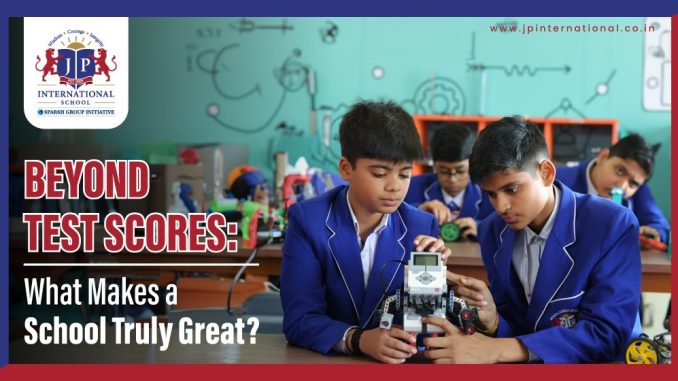
In an era of accelerating change, where the skills demanded by tomorrow’s world are often unknown today, the concept of an “innovative school” has moved from an idealistic aspiration to an urgent necessity. True educational innovation is far more than simply adopting the latest technology or sporting a sleek, modern building; it represents a fundamental rethinking of pedagogy, curriculum, assessment, and the very culture of learning itself. A genuinely innovative school is a dynamic ecosystem designed to foster adaptability, creativity, critical thinking, and a lifelong love of learning in its students, preparing them not just for existing careers, but for a future they will help shape.
At the core of a truly innovative school is a **courageous and forward-thinking vision** that challenges traditional paradigms. Such institutions are not content with merely perpetuating established norms; they possess a clear, articulated philosophy that dares to redefine what education can and should be. This vision often prioritizes student agency, deep inquiry, and interdisciplinary learning over rote memorization and siloed subjects. For example, instead of a rigid timetable with separate history, science, and art classes, an innovative school might design projects where students explore a historical period by building models (integrating engineering and art), researching the scientific advancements of the time, and debating the ethical dilemmas faced by historical figures. This integrated approach reflects the interconnectedness of real-world problems and fosters a more holistic understanding. The vision acts as a compass, guiding all decisions, from curriculum design to professional development.
Complementing this bold vision is a **flexible and responsive curriculum** that moves beyond prescribed textbooks and standardized tests. Innovative schools understand that knowledge is constantly evolving, and a static curriculum quickly becomes outdated. They emphasize concept-based learning, problem-solving, and the development of transferable skills over the mere accumulation of facts. This might involve project-based learning (PBL), where students engage in extended, authentic investigations of complex questions, culminating in real-world products or presentations. For instance, rather than simply studying climate change, students might design and implement a school-wide recycling program, analyze its impact, and present their findings to the local community. This experiential approach not only deepens understanding but also cultivates initiative, collaboration, and critical thinking. Furthermore, these schools often incorporate emerging fields like artificial intelligence, data literacy, and sustainable development directly into their core offerings, ensuring relevance for the future.
A distinguishing characteristic of innovative schools is their commitment to **reimagining assessment as a tool for learning, not just evaluation**. Moving beyond the limitations of traditional letter grades and high-stakes exams, these institutions embrace authentic assessment methods that provide meaningful feedback and genuinely reflect student mastery. This could include portfolios of student work, exhibitions of learning, presentations to external panels, or performance-based tasks that require applying knowledge to complex scenarios. The focus shifts from “what score did you get?” to “what did you learn, and how can you improve?” This feedback-rich environment encourages a growth mindset, where mistakes are viewed as opportunities for learning, and continuous improvement is prioritized over perfect outcomes. In Germany, where the education system often emphasizes academic rigor, innovative schools might still maintain high standards but complement them with qualitative assessments that provide a more holistic view of student progress.
Crucially, an innovative school cultivates a **culture of continuous learning and experimentation for both students and educators**. It recognizes that innovation is not a destination but a journey, and that failure is an integral part of the learning process. Teachers in such environments are encouraged to experiment with new pedagogical approaches, share their successes and failures, and engage in ongoing professional development that pushes the boundaries of their practice. This collaborative spirit extends to students, who are empowered to take risks, pursue their curiosities, and even contribute to the design of their own learning experiences. The school becomes a living laboratory, where inquiry and improvement are embedded in the very fabric of daily operations.
Finally, an innovative school leverages **technology as an enabler, not an end in itself**, and often builds strong **community partnerships**. Technology is integrated thoughtfully to personalize learning, facilitate collaboration, provide access to vast resources, and connect students with global perspectives. It’s not about having the latest gadgets, but about using tools strategically to enhance pedagogical goals. Furthermore, these schools understand that learning extends beyond classroom walls. They actively forge partnerships with local businesses, universities, non-profits, and community organizations, providing students with authentic learning experiences, mentorship opportunities, and real-world challenges. This interconnectedness enriches the curriculum, exposes students to diverse career paths, and ensures that education remains relevant to the broader societal context.
In conclusion, a school that is truly innovative transcends superficial reforms and embraces a holistic transformation of the learning experience. It is characterized by a bold vision, a flexible and responsive curriculum, authentic assessment practices, a culture of continuous learning and experimentation, strategic technological integration, and robust community partnerships. Such institutions are not merely preparing students for tests; they are cultivating adaptable, creative, and critically thinking individuals who are equipped not just to navigate the complexities of the future, but to actively shape it. This profound commitment to redefining education makes these schools beacons of excellence and models for what learning can and should be in the 21st century.